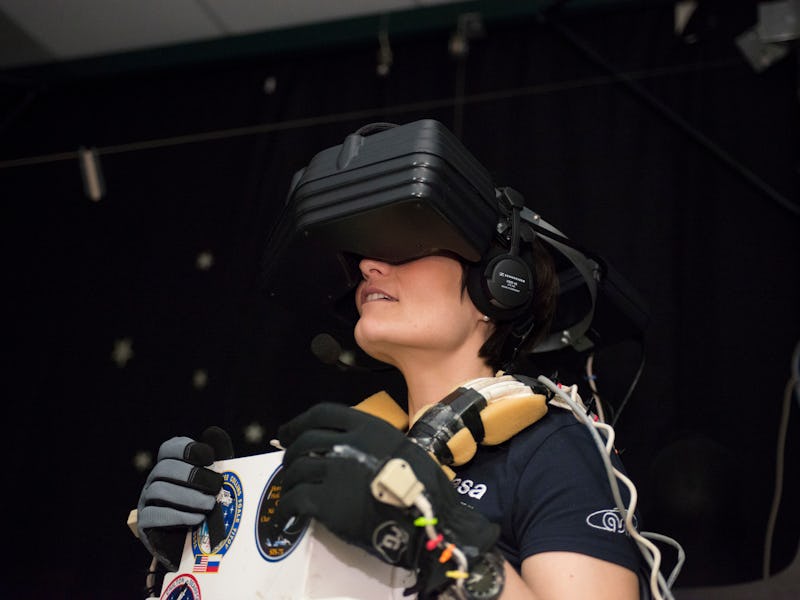Meet DOUG, the NASA Virtual Reality Tech Prepping Astronauts for Spacewalks
Immersive tech can prepare astronauts for the most dangerous (and expensive) missions of their lives.

NASA’s Johnson Space Center in Houston has housed a virtual reality laboratory since 1990. When it was created, 26 years ago, the idea of using VR to train astronauts for Extravehicular Activities (aka spacewalks) was pretty far out there. Today, the idea seems obvious. But the technology at play here is still very impressive.
Training astronauts who are jetting off into orbit means preparing them for a whole slew of operations, and unanticipated situations unlike anything experienced on Earth. This includes spacewalks, which is the act of going out of a spacecraft, with just a suit on and a rope keeping you attached to ship — or in emergencies, using a jet pack called SAFER for untethered activity — and performing a number of tasks with no gravity, friction, heat, or any of the other things we’re used to down here on the surface. NASA has two methods for simulating this environment to some degree. You can take a dive in Neutral Buoyancy Laboratory at the JSC, an underwater pool designed to simulate a zero gravity environment, or you take a ride on the most advanced virtual reality system ever designed at the JSC’s VR Lab.
When an astronaut-in-training puts on the headset, they’re looking at an artificial 3D environment rendered to reproduce everything an astronaut might see when they go on an actual spacewalk. The software that makes this happen — Dynamic Onboard Ubiquitous Graphics, or DOUG — makes it so that every astronaut who walks out the door of the spacecraft and takes their first (non) step into space can feel like they are follow something resembling a routine. DOUG is only a long pile of code and he has no personality, but when you’re using the VR system, he is your best friend.
NASA astronauts Clayton Anderson (left) and Rick Mastracchio use virtual-reality hardware in the Space Vehicle Mock-Up Facility at Johnson Space Center to rehearse some of their duties on an upcoming mission to the International Space Station.
The whole system links an array of sensors that track head, chest, and hand movements as well. A pair of gloves can reproduce a lot of the different things your hand in particular does. This includes when you close and open your palms, point, grasp an object, twist your wrist — everything.
One of the coolest parts of the VR Lab is to help train astronauts how to handle and manipulate objects in space. Without gravity, the rules we apply to handling something of a certain perceived size and weight go out the window. That’s where the Charlotte robot comes in — a device of eight motors controlling individual wires in a web-like contraption that automatically adjusts to emulate the behavior and motion of a specific object that would be sitting in space. Using the VR set in combination with Charlotte, an astronaut could learn how to rotate an object of a certain size to counter its spin in a zero-gravity or microgravity environment.
But the real purpose of the VR Lab is getting astronauts adjusted to using SAFER. Right now, this miniature jetpack is only meant for emergency situations during spacewalks aboard the ISS — and that’s never happened before. Nevertheless, every astronaut needs to learn what to do in case another crew member gets untethered from the station and starts spinning off into space, like in the movie Gravity.
The VR Lab has a mode that emulates the SAFER unit. You just strap in, take control of the joysticks, and take off into virtual space, learning how rotate yourself, move forward, slow down and speed up, and change directions. If NASA ever folds or decides it needs to raise money by selling off assets, the SAFER mode of the VR system would make a killer video game.
The VR Lab’s work is likely to expand as virtual reality technology gets better and better. NASA might even start ditching their own in-house systems for the Oculus Rift or another private application. And it’s almost certain that the VR Lab’s work will begin to train astronauts to adjust to other kinds of environments they might run into as well — like the moon, near-Earth asteroids that are rife for mining resources, and almost certainly Mars. Who knew fake space was the best way to prepare people for real space?